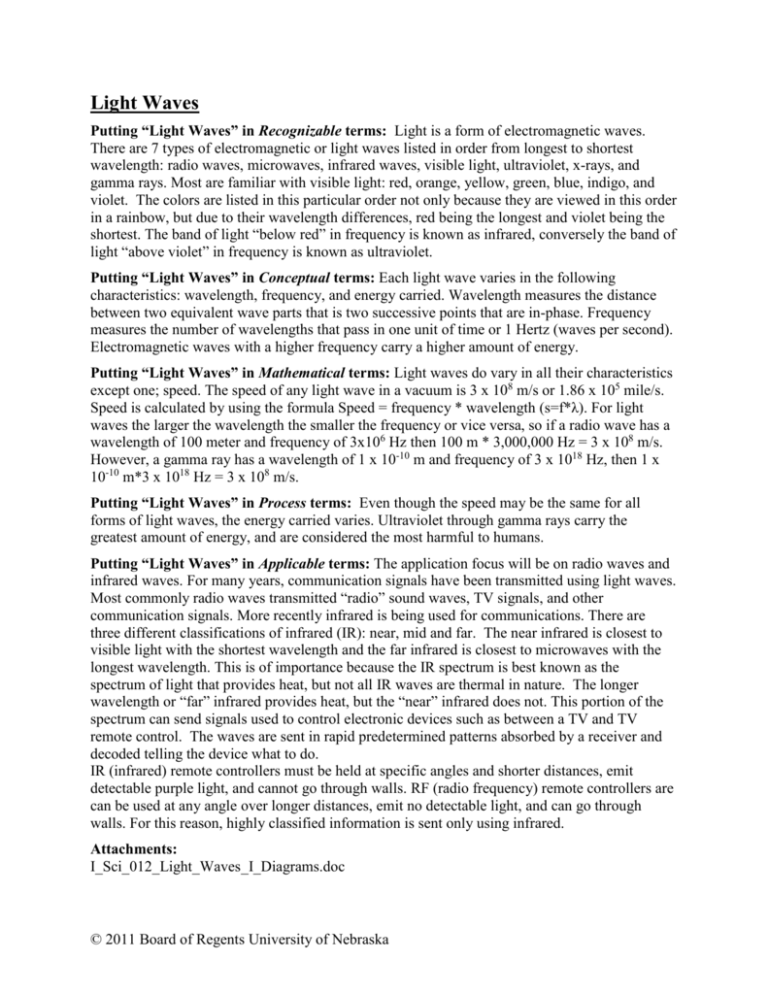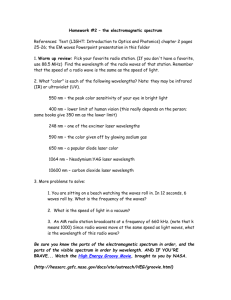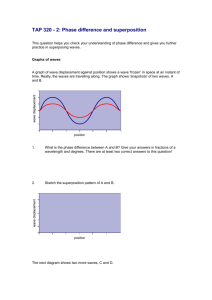Infrared Light waves
advertisement

Light Waves Putting “Light Waves” in Recognizable terms: Light is a form of electromagnetic waves. There are 7 types of electromagnetic or light waves listed in order from longest to shortest wavelength: radio waves, microwaves, infrared waves, visible light, ultraviolet, x-rays, and gamma rays. Most are familiar with visible light: red, orange, yellow, green, blue, indigo, and violet. The colors are listed in this particular order not only because they are viewed in this order in a rainbow, but due to their wavelength differences, red being the longest and violet being the shortest. The band of light “below red” in frequency is known as infrared, conversely the band of light “above violet” in frequency is known as ultraviolet. Putting “Light Waves” in Conceptual terms: Each light wave varies in the following characteristics: wavelength, frequency, and energy carried. Wavelength measures the distance between two equivalent wave parts that is two successive points that are in-phase. Frequency measures the number of wavelengths that pass in one unit of time or 1 Hertz (waves per second). Electromagnetic waves with a higher frequency carry a higher amount of energy. Putting “Light Waves” in Mathematical terms: Light waves do vary in all their characteristics except one; speed. The speed of any light wave in a vacuum is 3 x 108 m/s or 1.86 x 105 mile/s. Speed is calculated by using the formula Speed = frequency * wavelength (s=f*λ). For light waves the larger the wavelength the smaller the frequency or vice versa, so if a radio wave has a wavelength of 100 meter and frequency of 3x106 Hz then 100 m * 3,000,000 Hz = 3 x 108 m/s. However, a gamma ray has a wavelength of 1 x 10-10 m and frequency of 3 x 1018 Hz, then 1 x 10-10 m*3 x 1018 Hz = 3 x 108 m/s. Putting “Light Waves” in Process terms: Even though the speed may be the same for all forms of light waves, the energy carried varies. Ultraviolet through gamma rays carry the greatest amount of energy, and are considered the most harmful to humans. Putting “Light Waves” in Applicable terms: The application focus will be on radio waves and infrared waves. For many years, communication signals have been transmitted using light waves. Most commonly radio waves transmitted “radio” sound waves, TV signals, and other communication signals. More recently infrared is being used for communications. There are three different classifications of infrared (IR): near, mid and far. The near infrared is closest to visible light with the shortest wavelength and the far infrared is closest to microwaves with the longest wavelength. This is of importance because the IR spectrum is best known as the spectrum of light that provides heat, but not all IR waves are thermal in nature. The longer wavelength or “far” infrared provides heat, but the “near” infrared does not. This portion of the spectrum can send signals used to control electronic devices such as between a TV and TV remote control. The waves are sent in rapid predetermined patterns absorbed by a receiver and decoded telling the device what to do. IR (infrared) remote controllers must be held at specific angles and shorter distances, emit detectable purple light, and cannot go through walls. RF (radio frequency) remote controllers are can be used at any angle over longer distances, emit no detectable light, and can go through walls. For this reason, highly classified information is sent only using infrared. Attachments: I_Sci_012_Light_Waves_I_Diagrams.doc © 2011 Board of Regents University of Nebraska







